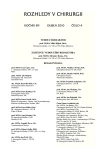Reliability of Load-Sharing Classification in Indications for Anterior Vertebral Body Replacement in Thoracolumbar Spine Fractures
Authors:
L. Hrabálek; T. Wanek; M. Adamus *; K. Langová **
Authors‘ workplace:
Neurochirurgická klinika FN a LF UP Olomouc, přednosta: prof. MUDr. M. Houdek, CSc.
; Klinika anesteziologie a resuscitace, přednosta: MUDr. J. Neiser
*; Ústav lékařské biofyziky, přednostka: doc. MUDr. H. Kolářová, CSc.
**
Published in:
Rozhl. Chir., 2010, roč. 89, č. 4, s. 223-228.
Category:
Monothematic special - Original
Overview
Introduction:
So far, the Load-Sharing Classification (LSC) has been the commonest method employed to identify indication for anterior replacement of vertebral bodies in thoracolumbar spine fractures. The aim of this study was to verify reliability of the LSC method in indications for anterior replacement surgery.
Methods:
Fractures were examined using x-ray, CT and MRI methods. The prospective study included only patients with type A3 comminuted fractures (AO classification) of the thoracolumbar vertebrae (Th11-L2), with MRI confirmed grade 3 or 4 intervertebral disc injuries (according to Oner) and with no concomitant nerve injuries. All fractures were treated using isolated posterior transpedicular (TP) fixation. 18 months after the procedure, angulation of the regional kyphosis, screw rupturing, Visual Analogue Scale (VAS) scores at rest and under loading, Pain Scale (PS) scores and Work Scale (WS) scores were assessed. The study group included 42 patients aged 27–72 years (the mean age was 51.55 y.o.a.), 28 subjects were males and 14 females. Using the LSC classification system, the study group was divided into two subgroups, one including patients with LSC up to grade 6 – Group A (18 subjects) and the other one including patients with LSC 7 to 9 – Group B (24 subjects).
Results:
Statistical assessment of clinical (PS, WS, VAS at rest and VAS after loading) and radiological findings (the degree of kyphotic changes) at month 18 identified no statistically significant correlations between the two subgroups. TP fixation failures (srews rupturing) occured only in Group A in two subjects.
Discussion:
Based on the LSC, Group B was expected to have inferior outcomes, however, this was not the case in our study group. Therefore, it can be concluded that LSC is not a reliable predictor of the final clinical and radiological findings in the type A3 fractures with grade 3 or 4 TH-L intervertebral disc injuries. The defined LSC 6- point threshold for indications for anterior vertebral body and disc replacements is arguable.
Conclusion:
The authors do not consider the LSC method sufficiently reliable for determining indications for anterior replacements.
Key words:
injury – thoracolumbar spine – classification of spine fractures – transpedicular fixation –vertebral body replacement
Sources
1. McCormack, T., Karaikovic, E., Gaines, R. W. The load sharing classification of spine fractures. Spine, 1994; 19: 1741–1744.
2. Oner, F. C., van Gils, A. P., Dhert, W. J., Verbout, A. J. MRI findings of thoracolumbar spine fractures: a categorisation based on MRI examinations of 100 fractures. Skeletal. Radiol., 1999; 28: 433–443.
3. Magerl, F., Aebi, M., Gertzbein, S. D., Harms, J., Nazarian, S. A comprehensive classification of thoracic and lumbar injuries. Eur. Spine J., 1994; 3: 184–201.
4. Carlsson, A. M. Assessment of chronic pain: I. Aspects of the reliability and validity of the visual analogue scale. Pain, 1983; 16: 87–101.
5. Denis, F., Armstrong, G. W. D., Searls, K., Matta, L. Acute thoracolumbar burst fractures in the absence of neurological deficit: A comparison between operative and nonoperative treatment. Clin. Orthop., 1984; 189: 142.
6. Parker, J. W., Lane, J. R., Karaikovic, E., Gaines, R. W. Successful short-segment instrumentation and fusion for thoracolumbar spine fractures. Spine, 2000; 25: 1157–1169.
7. Hrabálek, L., Bučil, J., Vaverka, M., Houdek, M., Krahulík, D., Kalita, O. Indikace přední náhrady meziobratlové ploténky u zlomenin hrudní a bederní páteře s využitím magnetické rezonance – prospektivní studie. Cesk. Slov. Neurol. N., 2009; 72/105 (2): 132–140.
8. Hrabálek, L., Houdek, M., Vaverka, M. Přínos magnetické rezonance pro diagnostiku a léčbu poranění torakolumbální páteře. Rozhl. Chir., 2009; 88: 461–465.
9. Blauth, M., Bastion, L., Knop, C., Lange, U., Tuch, G. Intraobserverreliabilitat bei der Klassifikation von thorakolumbalen Wirbelsaulenverletzungen. Orthopade, 1999; 28: 662–681.
10. Oner, F. C., Ramos, L. M. P., Simmermacher, R. K. J., Kingma, P. T. D., Diekerhof, C. H., Dhert, W. J. A., Vetnout, A. J. Classification of thoracic and lumbar spine fractures: problems of reproducibility. Eur. Spine J., 2002; 11: 235–245.
11. Lukáš, R., Suchomel, P., Šrám, J., Endrych L. Klasifikací řízená volba operačního přístupu při operačním léčení zlomenin torakolumbární páteře. Rozhl. Chir., 2006; 85 (7): 365–372.
12. Lukáš, R., Taller, S. Vývoj klasifikací zlomenin T-L páteře. Acta spondylologica, 2002; 1: 31–38.
13. Vaccaro, A. R., Lehman, R. A., Hurlbert, R. J., Anderson, P. A., Harris, M., Hedlund, R., et al. A new classification of thoracolumbar injuries: The importance of injury morphology, the integrity of the posterior ligamentous complex, and neurological status. Spine, 2005; 30: 2325–2333.
14. Patel, A. A., Dailey, A., Brodke, D. S., Daubs, M., Harrop, J., Whang, P. G., Vaccaro, A. R. Thoracolumbar spine trauma classification: the Thoracolumbar Injury Classification and Severity Score system and case examples. J. Neurosurg. Spine, 2009: 10: 201–206.
15. Rihn, J. A., Anderson, D. T., Hartus, E., Lawrence, J., Jonsson, H., Wilsey, J., Hurlbert, R. J., Vaccaro, A. R. A review of the TLICS system: o novel, user-friendly thoracolumbar trauma classification system. Acta Orthopaedica, 2008: 79: 461–466.
16. Oner, F. C., van Gils, A. P., Faber, J. A. J., Dhert, W. J., Verbout, A. J. Some complications of common treatment schemes of thoracolumbar spine fractures can be predicted with magnetic resonance imaging: prospective study of 53 patients with 71 fractures. Spine, 2002; 27: 629–636.
Labels
Surgery Orthopaedics Trauma surgeryArticle was published in
Perspectives in Surgery

2010 Issue 4
Most read in this issue
- Malignant Ascites – Optional Management using Hyperthermic Peroperative Chemotherapy (HIPEC)
- Mesenteric Ischemia – Late Diagnosis or Managed Disease?
- Stapler Procedure for Anal Prolapse and Hemorrhoids: Long-term Results
- Rare Tumors of the Gallbladder and Bile Ducts. A Case Review
